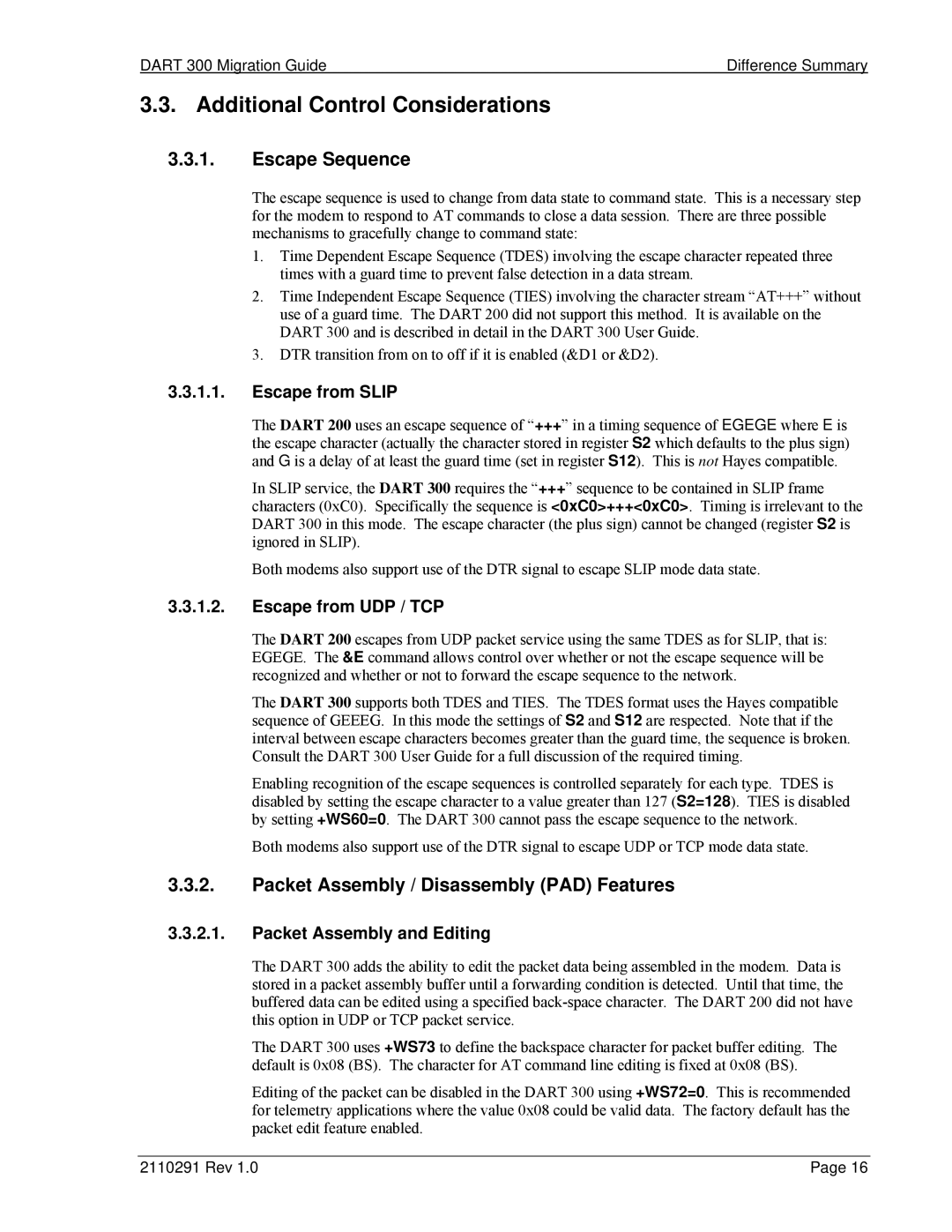DART 300 Migration Guide | Difference Summary |
3.3.Additional Control Considerations
3.3.1.Escape Sequence
The escape sequence is used to change from data state to command state. This is a necessary step for the modem to respond to AT commands to close a data session. There are three possible mechanisms to gracefully change to command state:
1.Time Dependent Escape Sequence (TDES) involving the escape character repeated three times with a guard time to prevent false detection in a data stream.
2.Time Independent Escape Sequence (TIES) involving the character stream “AT+++” without use of a guard time. The DART 200 did not support this method. It is available on the DART 300 and is described in detail in the DART 300 User Guide.
3.DTR transition from on to off if it is enabled (&D1 or &D2).
3.3.1.1.Escape from SLIP
The DART 200 uses an escape sequence of “+++” in a timing sequence of EGEGE where E is the escape character (actually the character stored in register S2 which defaults to the plus sign) and G is a delay of at least the guard time (set in register S12). This is not Hayes compatible.
In SLIP service, the DART 300 requires the “+++” sequence to be contained in SLIP frame characters (0xC0). Specifically the sequence is <0xC0>+++<0xC0>. Timing is irrelevant to the DART 300 in this mode. The escape character (the plus sign) cannot be changed (register S2 is ignored in SLIP).
Both modems also support use of the DTR signal to escape SLIP mode data state.
3.3.1.2.Escape from UDP / TCP
The DART 200 escapes from UDP packet service using the same TDES as for SLIP, that is: EGEGE. The &E command allows control over whether or not the escape sequence will be recognized and whether or not to forward the escape sequence to the network.
The DART 300 supports both TDES and TIES. The TDES format uses the Hayes compatible sequence of GEEEG. In this mode the settings of S2 and S12 are respected. Note that if the interval between escape characters becomes greater than the guard time, the sequence is broken. Consult the DART 300 User Guide for a full discussion of the required timing.
Enabling recognition of the escape sequences is controlled separately for each type. TDES is disabled by setting the escape character to a value greater than 127 (S2=128). TIES is disabled by setting +WS60=0. The DART 300 cannot pass the escape sequence to the network.
Both modems also support use of the DTR signal to escape UDP or TCP mode data state.
3.3.2.Packet Assembly / Disassembly (PAD) Features
3.3.2.1.Packet Assembly and Editing
The DART 300 adds the ability to edit the packet data being assembled in the modem. Data is stored in a packet assembly buffer until a forwarding condition is detected. Until that time, the buffered data can be edited using a specified
The DART 300 uses +WS73 to define the backspace character for packet buffer editing. The default is 0x08 (BS). The character for AT command line editing is fixed at 0x08 (BS).
Editing of the packet can be disabled in the DART 300 using +WS72=0. This is recommended for telemetry applications where the value 0x08 could be valid data. The factory default has the packet edit feature enabled.
2110291 Rev 1.0 | Page 16 |
